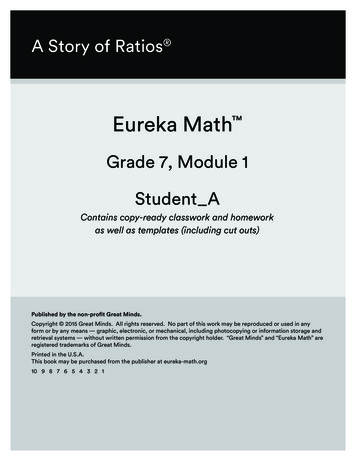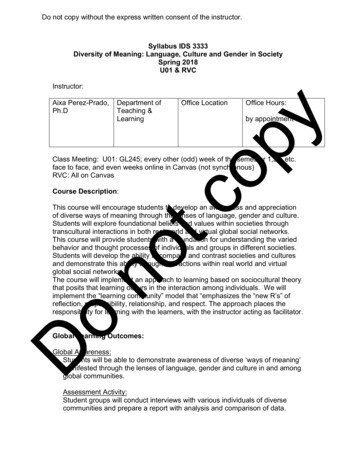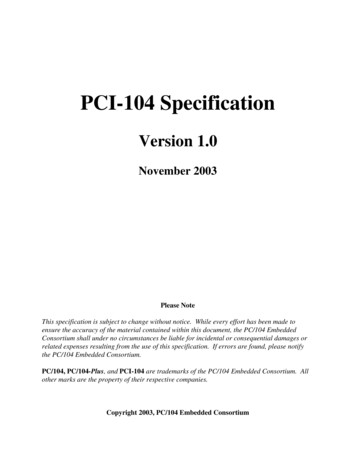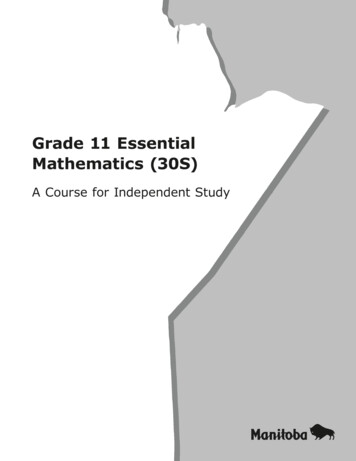
Transcription
A Story of Ratios Eureka Math Grade 7, Module 1Student AContains copy-ready classwork and homeworkas well as templates (including cut outs)Published by the non-profit Great Minds.Copyright 2015 Great Minds. All rights reserved. No part of this work may be reproduced or used in anyform or by any means — graphic, electronic, or mechanical, including photocopying or information storage andretrieval systems — without written permission from the copyright holder. “Great Minds” and “Eureka Math” areregistered trademarks of Great Minds.Printed in the U.S.A.This book may be purchased from the publisher at eureka-math.org10 9 8 7 6 5 4 3 2 1
Lesson 1A STORY OF RATIOS7 1Lesson 1: An Experience in Relationships as Measuring RateClassworkExample 1: How Fast Is Our Class?Record the results from the paper-passing exercise in the table below.Key Terms from Grade 6 Ratios and Unit RatesA ratio is an ordered pair of numbers which are not both zero. A ratio is denoted 𝐴𝐴: 𝐵𝐵 to indicate the order of thenumbers: the number 𝐴𝐴 is first, and the number 𝐵𝐵 is second.Two ratios 𝐴𝐴: 𝐵𝐵 and 𝐶𝐶: 𝐷𝐷 are equivalent ratios if there is a nonzero number 𝑐𝑐 such that𝐶𝐶 𝑐𝑐𝑐𝑐 and 𝐷𝐷 𝑐𝑐𝑐𝑐. For example, two ratios are equivalent if they both have values that are equal.A ratio relationship between two types of quantities, such as 5 miles per 2 hours, can be described as a rate (i.e., thequantity 2.5 miles/hour).The numerical part of the rate is called the unit rate and is simply the value of the ratio, in this case 2.5. This meansthat in 1 hour the car travels 2.5 miles. The unit for the rate is miles/hour, read miles per hour.TrialNumber of PapersPassedTime(in seconds)Ratio of Number ofPapers Passed to TimeRateUnit Rate123Lesson 1:An Experience in Relationships as Measuring RateThis work is derived from Eureka Math and licensed by Great Minds. 2015 -Great Minds. eureka math.orgG7-M1-SE-1.3.0-05.2015S.1
Lesson 1A STORY OF RATIOS7 1Example 2: Our Class by GenderNumber of BoysNumber of GirlsRatio of Boys to GirlsClass 1Class 2Whole 7th GradeCreate a pair of equivalent ratios by making a comparison of quantities discussed in this Example.Exercise 1: Which is the Better Buy?Value-Mart is advertising a Back-to-School sale on pencils. A pack of 30 sells for 7.97, whereas a 12-pack of the samebrand costs 4.77. Which is the better buy? How do you know?Lesson 1:An Experience in Relationships as Measuring RateThis work is derived from Eureka Math and licensed by Great Minds. 2015 -Great Minds. eureka math.orgG7-M1-SE-1.3.0-05.2015S.2
Lesson 1A STORY OF RATIOS7 1Lesson SummaryUnit rate is often a useful means for comparing ratios and their associated rates when measured in different units.The unit rate allows us to compare varying sizes of quantities by examining the number of units of one quantity perone unit of the second quantity. This value of the ratio is the unit rate.Problem Set1.Find each rate and unit rate.a.b.c.d.2.420 miles in 7 hours360 customers in 30 days40 meters in 16 seconds 7.96 for 5 poundsWrite three ratios that are equivalent to the one given: The ratio of right-handed students to left-handed studentsis 18: 4.3.Mr. Rowley has 16 homework papers and 14 exit tickets to return. Ms. Rivera has 64 homework papers and 60 exittickets to return. For each teacher, write a ratio to represent the number of homework papers to number of exittickets they have to return. Are the ratios equivalent? Explain.4.Jonathan’s parents told him that for every 5 hours of homework or reading he completes, he would be able to play3 hours of video games. His friend Lucas’s parents told their son that he could play 30 minutes for every hour ofhomework or reading time he completes. If both boys spend the same amount of time on homework and readingthis week, which boy gets more time playing video games? How do you know?5.Of the 30 girls who tried out for the lacrosse team at Euclid Middle School, 12 were selected. Of the 40 boys whotried out, 16 were selected. Are the ratios of the number of students on the team to the number of students tryingout the same for both boys and girls? How do you know?6.Devon is trying to find the unit price on a 6-pack of drinks on sale for 2.99. His sister says that at that price, eachdrink would cost just over 2.00. Is she correct, and how do you know? If she is not, how would Devon’s sister findthe correct price?7.Each year Lizzie’s school purchases student agenda books, which are sold in the school store. This year, the schoolpurchased 350 books at a cost of 1,137.50. If the school would like to make a profit of 1,500 to help pay for fieldtrips and school activities, what is the least amount they can charge for each agenda book? Explain how you foundyour answer.Lesson 1:An Experience in Relationships as Measuring RateThis work is derived from Eureka Math and licensed by Great Minds. 2015 -Great Minds. eureka math.orgG7-M1-SE-1.3.0-05.2015S.3
Lesson 2A STORY OF RATIOS7 1Lesson 2: Proportional RelationshipsClassworkExample 1: Pay by the Ounce Frozen YogurtA new self-serve frozen yogurt store opened this summer that sells its yogurt at a price based upon the total weight ofthe yogurt and its toppings in a dish. Each member of Isabelle’s family weighed his dish, and this is what they found.Determine if the cost is proportional to the weight.Weight (ounces)12.5Cost ( )10554283.20The cost the weight.Example 2: A Cooking Cheat SheetIn the back of a recipe book, a diagram provides easy conversions to use while cooking.Cups011211481222Ounces016The ounces the cups.Lesson 2:Proportional RelationshipsThis work is derived from Eureka Math and licensed by Great Minds. 2015 -Great Minds. eureka math.orgG7-M1-SE-1.3.0-05.2015S.4
Lesson 2A STORY OF RATIOS7 1Exercise 1During Jose’s physical education class today, students visited activity stations. Next to each station was a chart depictinghow many calories (on average) would be burned by completing the activity.Calories Burned While Jumping RopeTime (minutes)01234011223344Calories Burneda.Is the number of calories burned proportional to time? How do you know?b.If Jose jumped rope for 6.5 minutes, how many calories would he expect to burn?Lesson 2:Proportional RelationshipsThis work is derived from Eureka Math and licensed by Great Minds. 2015 -Great Minds. eureka math.orgG7-M1-SE-1.3.0-05.2015S.5
Lesson 2A STORY OF RATIOS7 1Example 3: Summer JobAlex spent the summer helping out at his family’s business. He was hoping to earn enough money to buy a new 220gaming system by the end of the summer. Halfway through the summer, after working for 4 weeks, he had earned 112. Alex wonders, “If I continue to work and earn money at this rate, will I have enough money to buy the gamingsystem by the end of the summer?”To determine if he will earn enough money, he decided to make a table. He entered his total money earned at the endof Week 1 and his total money earned at the end of Week 4.WeekTotalEarnings01 28234 112567a.Work with a partner to answer Alex’s question.b.Are Alex’s total earnings proportional to the number of weeks he worked? How do you know?Lesson 2:Proportional RelationshipsThis work is derived from Eureka Math and licensed by Great Minds. 2015 -Great Minds. eureka math.orgG7-M1-SE-1.3.0-05.20158S.6
Lesson 2A STORY OF RATIOS7 1Lesson SummaryMeasures of one type of quantity are proportional to measures of a second type of quantity if there is a number 𝑘𝑘 sothat for every measure 𝑥𝑥 of a quantity of the first type, the corresponding measure 𝑦𝑦 of a quantity of the secondtype is given by 𝑘𝑘𝑘𝑘; that is, 𝑦𝑦 𝑘𝑘𝑘𝑘. The number 𝑘𝑘 is called the constant of proportionality.A proportional relationship is a correspondence between two types of quantities such that the measures ofquantities of the first type are proportional to the measures of quantities of the second type.Note that proportional relationships and ratio relationships describe the same set of ordered pairs but in twodifferent ways. Ratio relationships are used in the context of working with equivalent ratios, while proportionalrelationships are used in the context of rates.In the example given below, the distance is proportional to time since each measure of distance, 𝑦𝑦, can be calculatedby multiplying each corresponding time, 𝑡𝑡, by the same value, 10. This table illustrates a proportional relationshipbetween time, 𝑡𝑡, and distance, 𝑦𝑦.Time (h), 𝒕𝒕Distance (km), 𝒚𝒚00110220330Problem Set1.A cran-apple juice blend is mixed in a ratio of cranberry to apple of 3 to 5.a.Complete the table to show different amounts that are proportional.Amount of CranberryAmount of Appleb.2.Why are these quantities proportional?John is filling a bathtub that is 18 inches deep. He notices that it takes two minutes to fill the tub with three inchesof water. He estimates it will take 10 more minutes for the water to reach the top of the tub if it continues at thesame rate. Is he correct? Explain.Lesson 2:Proportional RelationshipsThis work is derived from Eureka Math and licensed by Great Minds. 2015 -Great Minds. eureka math.orgG7-M1-SE-1.3.0-05.2015S.7
Lesson 3A STORY OF RATIOS7 1Lesson 3: Identifying Proportional and Non-ProportionalRelationships in TablesClassworkExampleYou have been hired by your neighbors to babysit their children on Friday night. You are paid 8 per hour. Completethe table relating your pay to the number of hours you worked.Hours WorkedPay1234412566.5Based on the table above, is the pay proportional to the hours worked? How do you know?Lesson 3:Identifying Proportional and Non-Proportional Relationships in TablesThis work is derived from Eureka Math and licensed by Great Minds. 2015 -Great Minds. eureka math.orgG7-M1-SE-1.3.0-05.2015S.8
Lesson 3A STORY OF RATIOS7 1ExercisesFor Exercises 1–3, determine if 𝑦𝑦 is proportional to 𝑥𝑥. Justify your answer.1.The table below represents the relationship of the amount of snowfall (in inches) in 5 counties to the amount oftime (in hours) hours of a recent winter storm.𝒙𝒙Time (h)2682.572.𝒚𝒚Snowfall (in.)101216514The table below shows the relationship between the cost of renting a movie (in dollars) to the number of days themovie is rented.𝒙𝒙Number of Days69243Lesson 3:𝒚𝒚Cost (dollars)2381Identifying Proportional and Non-Proportional Relationships in TablesThis work is derived from Eureka Math and licensed by Great Minds. 2015 -Great Minds. eureka math.orgG7-M1-SE-1.3.0-05.2015S.9
Lesson 3A STORY OF RATIOS3.The table below shows the relationship between the amount of candy bought (in pounds) and the total cost of thecandy (in dollars).𝒙𝒙Amount ofCandy (pounds)5468104.7 1𝒚𝒚Cost (dollars)108121620Randy is planning to drive from New Jersey to Florida. Every time Randy stops for gas, he records the distance hetraveled in miles and the total number of gallons used.Assume that the number of miles driven is proportional to the number of gallons consumed in order to completethe table.Gallons ConsumedMiles Driven254Lesson 3:41898216Identifying Proportional and Non-Proportional Relationships in TablesThis work is derived from Eureka Math and licensed by Great Minds. 2015 -Great Minds. eureka math.orgG7-M1-SE-1.3.0-05.20151012S.10
Lesson 3A STORY OF RATIOS7 1Lesson SummaryA type of quantity is proportional to a second if there is a constant number such that the product of each measure ofthe first type and the constant is equal to the corresponding measure of the second type.Steps to determine if quantities in a table are proportional to each other:1.For each row (or column), calculatesecond quantity.2.If the value ofother.𝐵𝐵𝐴𝐴𝐵𝐵𝐴𝐴where 𝐴𝐴 is the measure of the first quantity, and 𝐵𝐵 is the measure of theis the same for each pair of numbers, then the quantities in the table are proportional to eachProblem SetIn each table, determine if 𝑦𝑦 is proportional to 𝑥𝑥. Explain why or why 9213.𝒙𝒙69123𝒚𝒚4682Kayla made observations about the selling price of a new brand of coffee that sold in three different-sized bags. Sherecorded those observations in the following table:Ounces of CoffeePrice in Dollars5.𝒙𝒙34566 2.108 2.80a.Is the price proportional to the amount of coffee? Why or why not?b.Use the relationship to predict the cost of a 20 oz. bag of coffee.16 5.60You and your friends go to the movies. The cost of admission is 9.50 per person. Create a table showing therelationship between the number of people going to the movies and the total cost of admission.Explain why the cost of admission is proportional to the amount of people.6.For every 5 pages Gil can read, his daughter can read 3 pages. Let 𝑔𝑔 represent the number of pages Gil reads, andlet 𝑑𝑑 represent the number of pages his daughter reads. Create a table showing the relationship between thenumber of pages Gil reads and the number of pages his daughter reads.Is the number of pages Gil’s daughter reads proportional to the number of pages he reads? Explain why or why not.Lesson 3:Identifying Proportional and Non-Proportional Relationships in TablesThis work is derived from Eureka Math and licensed by Great Minds. 2015 -Great Minds. eureka math.orgG7-M1-SE-1.3.0-05.2015S.11
Lesson 3A STORY OF RATIOS7.The table shows the relationship between the number of parents in a household and the number of children in thesame household. Is the number of children proportional to the number of parents in the household? Explain whyor why not.Number ofParents011228.9.7 1Number ofChildren03541The table below shows the relationship between the number of cars sold and the amount of money earned by thecar salesperson. Is the amount of money earned, in dollars, proportional to the number of cars sold? Explain why orwhy not.Number of CarsSold12345Money Earned(in dollars)2506009501,0761,555Make your own example of a relationship between two quantities that is NOT proportional. Describe the situation,and create a table to model it. Explain why one quantity is not proportional to the other.Lesson 3:Identifying Proportional and Non-Proportional Relationships in TablesThis work is derived from Eureka Math and licensed by Great Minds. 2015 -Great Minds. eureka math.orgG7-M1-SE-1.3.0-05.2015S.12
Lesson 4A STORY OF RATIOS7 1Lesson 4: Identifying Proportional and Non-ProportionalRelationships in TablesClassworkExample: Which Team Will Win the Race?You have decided to walk in a long-distance race. There are two teams that you can join. Team A walks at a constantrate of 2.5 miles per hour. Team B walks 4 miles the first hour and then 2 miles per hour after that.Task: Create a table for each team showing the distances that would be walked for times of 1, 2, 3, 4, 5, and 6 hours.Using your tables, answer the questions that follow.Team ADistanceTime (h)(miles)Team BDistanceTime (h)(miles)a.For which team is distance proportional to time? Explain your reasoning.b.Explain how you know distance for the other team is not proportional to time.Lesson 4:Identifying Proportional and Non-Proportional Relationships in TablesThis work is derived from Eureka Math and licensed by Great Minds. 2015 -Great Minds. eureka math.orgG7-M1-SE-1.3.0-05.2015S.13
Lesson 4A STORY OF RATIOS7 1c.At what distance in the race would it be better to be on Team B than Team A? Explain.d.If the members on each team walked for 10 hours, how far would each member walk on each team?e.Will there always be a winning team, no matter what the length of the course? Why or why not?f.If the race is 12 miles long, which team should you choose to be on if you wish to win? Why would you choosethis team?g.How much sooner would you finish on that team compared to the other team?Lesson 4:Identifying Proportional and Non-Proportional Relationships in TablesThis work is derived from Eureka Math and licensed by Great Minds. 2015 -Great Minds. eureka math.orgG7-M1-SE-1.3.0-05.2015S.14
Lesson 4A STORY OF RATIOS7 1Exercises1.Bella types at a constant rate of 42 words per minute. Is the number of words she can type proportional to thenumber of minutes she types? Create a table to determine the relationship.MinutesNumber of Words2.123660Mark recently moved to a new state. During the first month, he visited five state parks. Each month after, hevisited two more. Complete the table below, and use the results to determine if the number of parks visited isproportional to the number of months.Number of MonthsNumber of State Parks123Lesson 4:23Identifying Proportional and Non-Proportional Relationships in TablesThis work is derived from Eureka Math and licensed by Great Minds. 2015 -Great Minds. eureka math.orgG7-M1-SE-1.3.0-05.2015S.15
Lesson 4A STORY OF RATIOS3.7 1The table below shows the relationship between the side length of a square and the area. Complete the table.Then, determine if the length of the sides is proportional to the area.Side Length(inches)Area(square inches)1123445812Lesson 4:Identifying Proportional and Non-Proportional Relationships in TablesThis work is derived from Eureka Math and licensed by Great Minds. 2015 -Great Minds. eureka math.orgG7-M1-SE-1.3.0-05.2015S.16
Lesson 4A STORY OF RATIOS7 1Problem Set1.Joseph earns 15 for every lawn he mows. Is the amount of money he earns proportional to the number of lawnshe mows? Make a table to help you identify the type of relationship.Number of Lawns MowedEarnings ( )2.At the end of the summer, Caitlin had saved 120 from her summer job. This was her initial deposit into a newsavings account at the bank. As the school year starts, Caitlin is going to deposit another 5 each week from herallowance. Is her account balance proportional to the number of weeks of deposits? Use the table below. Explainyour reasoning.Time (in weeks)Account Balance ( )3.Lucas and Brianna read three books each last month. The table shows the number of pages in each book and thelength of time it took to read the entire book.Pages Lucas ReadTime (hours)208815662349Pages Brianna ReadTime (hours)1686120434812a.Which of the tables, if any, shows a proportional relationship?b.Both Lucas and Brianna had specific reading goals they needed to accomplish. What different strategies dideach person employ in reaching those goals?Lesson 4:Identifying Proportional and Non-Proportional Relationships in TablesThis work is derived from Eureka Math and licensed by Great Minds. 2015 -Great Minds. eureka math.orgG7-M1-SE-1.3.0-05.2015S.17
Lesson 5A STORY OF RATIOS7 1Lesson 5: Identifying Proportional and Non-ProportionalRelationships in GraphsClassworkOpening ExerciseIsaiah sold candy bars to help raise money for his scouting troop. The table shows the amount of candy he soldcompared to the money he received.𝒙𝒙Candy Bars Sold24812𝒚𝒚Money Received ( )35912Is the amount of candy bars sold proportional to the money Isaiah received? How do you know?Exploratory Challenge: From a Table to a GraphUsing the ratio provided, create a table that shows money received is proportional to the number of candy bars sold.Plot the points in your table on the grid.141312𝒙𝒙𝒚𝒚11Candy Bars SoldMoney Received ( )109238765432100 1 2 3 4 5 6 7 8 9 10Lesson 5:Identifying Proportional and Non-Proportional Relationships in GraphsThis work is derived from Eureka Math and licensed by Great Minds. 2015 -Great Minds. eureka math.orgG7-M1-SE-1.3.0-05.2015S.18
Lesson 5A STORY OF RATIOS7 1Important Note:Characteristics of graphs of proportional relationships:Example 114131211109876543210𝒙𝒙Candy Bars Sold𝒚𝒚Money Received ( )452Money Received, 𝑦𝑦Graph the points from the Opening Exercise.38912120 1 2 3 4 5 6 7 8 9 10 11 12 13 14Number of Candy Bars Sold, 𝑥𝑥Example 2Graph the points provided in the table below, and describe the similarities and differences when comparing your graphto the graph in Example 1.𝒚𝒚39066121218915Similarities with Example 1:Differences from Example 1:Lesson 5:20181614121086420𝑦𝑦𝒙𝒙0 1 2 3 4 5 6 7 8 9 10 11 12 13 14𝑥𝑥Identifying Proportional and Non-Proportional Relationships in GraphsThis work is derived from Eureka Math and licensed by Great Minds. 2015 -Great Minds. eureka math.orgG7-M1-SE-1.3.0-05.2015S.19
7 1Lesson 5A STORY OF RATIOSLesson SummaryWhen two proportional quantities are graphed on a coordinate plane, the points appear on a line that passesthrough the origin.Problem SetDetermine whether or not the following graphs represent two quantities that are proportional to each other.Explain your reasoning.b.Donated Money vs. Donations Matchedby BenefactorAge vs. Admission Price8500Admission Price ( )Donations Matched by Benefactor ( )a.4003002001000765432100c.100200300Money Donated400500012345678Age (years)Extra Credit vs. Number of ProblemsExtra Credit Points1.20181614121086420012345678Number of Problems SolvedLesson 5:Identifying Proportional and Non-Proportional Relationships in GraphsThis work is derived from Eureka Math and licensed by Great Minds. 2015 -Great Minds. eureka math.orgG7-M1-SE-1.3.0-05.2015S.20
Lesson 5A STORY OF RATIOS2.7 1Create a table and a graph for the ratios 2: 22, 3 to 15, and 1: 11. Does the graph show that the two quantities areproportional to each other? Explain why or why 23𝑥𝑥45Graph the following tables, and identify if the two quantities are proportional to each other on the graph. Explainwhy or why 456789 10 11 ��𝑦3.0012345𝑥𝑥Lesson 5:Identifying Proportional and Non-Proportional Relationships in GraphsThis work is derived from Eureka Math and licensed by Great Minds. 2015 -Great Minds. eureka math.orgG7-M1-SE-1.3.0-05.2015S.21
Lesson 6A STORY OF RATIOS7 1Lesson 6: Identifying Proportional and Non-ProportionalRelationships in GraphsClassworkToday’s Exploratory Challenge is an extension of Lesson 5. You will be working in groups to create a table and graph andto identify whether the two quantities are proportional to each other.Poster LayoutUse for notesProblem:Table:Graph:Proportional or Not? Explanation:Lesson 6:Identifying Proportional and Non-Proportional Relationships in GraphsThis work is derived from Eureka Math and licensed by Great Minds. 2015 -Great Minds. eureka math.orgG7-M1-SE-1.3.0-05.2015S.22
Lesson 6A STORY OF RATIOS7 1Gallery WalkTake notes and answer the following questions: Were there any differences found in groups that had the same ratios? Did you notice any common mistakes? How might they be fixed? Were there any groups that stood out by representing their problem and findings exceptionally clearly?Poster 1:Poster 2:Poster 3:Poster 4:Lesson 6:Identifying Proportional and Non-Proportional Relationships in GraphsThis work is derived from Eureka Math and licensed by Great Minds. 2015 -Great Minds. eureka math.orgG7-M1-SE-1.3.0-05.2015S.23
Lesson 6A STORY OF RATIOS7 1Poster 5:Poster 6:Poster 7:Poster 8:Note about Lesson Summary:Lesson 6:Identifying Proportional and Non-Proportional Relationships in GraphsThis work is derived from Eureka Math and licensed by Great Minds. 2015 -Great Minds. eureka math.orgG7-M1-SE-1.3.0-05.2015S.24
Lesson 6A STORY OF RATIOS7 1Lesson SummaryThe plotted points in a graph of a proportional relationship lie on a line that passes through the origin.Problem SetSally’s aunt put money in a savings account for her on the day Sally was born. The savings account pays interest forkeeping her money in the bank. The ratios below represent the number of years to the amount of money in the savingsaccount. After one year, the interest accumulated, and the total in Sally’s account was 312.After three years, the total was 340. After six years, the total was 380.After nine years, the total was 430. After 12 years, the total amount in Sally’s savings account was 480.Using the same four-fold method from class, create a table and a graph, and explain whether the amount of moneyaccumulated and the time elapsed are proportional to each other. Use your table and graph to support your reasoning.Lesson 6:Identifying Proportional and Non-Proportional Relationships in GraphsThis work is derived from Eureka Math and licensed by Great Minds. 2015 -Great Minds. eureka math.orgG7-M1-SE-1.3.0-05.2015S.25
Lesson 7A STORY OF RATIOS7 1Lesson 7: Unit Rate as the Constant of ProportionalityClassworkExample 1: National Forest Deer Population in Danger?Wildlife conservationists are concerned that the deer population might not be constant across the National Forest. Thescientists found that there were 144 deer in a 16-square-mile area of the forest. In another part of the forest,conservationists counted 117 deer in a 13-square-mile area. Yet a third conservationist counted 216 deer in a24-square-mile plot of the forest. Do conservationists need to be worried?a.Why does it matter if the deer population is not constant in a certain area of the National Forest?b.What is the population density of deer per square mile?The unit rate of deer per 1 square mile is .Constant of Proportionality:Explain the meaning of the constant of proportionality in this problem:c.𝑦𝑦Use the unit rate of deer per square mile (or ) to determine how many deer there are for every 207 square𝑥𝑥miles.d.Use the unit rate to determine the number of square miles in which you would find 486 deer.Lesson 7:Unit Rate as the Constant of ProportionalityThis work is derived from Eureka Math and licensed by Great Minds. 2015 -Great Minds. eureka math.orgG7-M1-SE-1.3.0-05.2015S.26
Lesson 7A STORY OF RATIOS7 1VocabularyA variable is a symbol (such as a letter) that is a placeholder for a number.If a proportional relationship is described by the set of ordered pairs (𝑥𝑥, 𝑦𝑦) that satisfies the equation 𝑦𝑦 𝑘𝑘𝑘𝑘 forsome number 𝑘𝑘, then 𝑘𝑘 is called the constant of proportionality. It is the number that describes the multiplicativerelationship between measures, 𝑥𝑥 and 𝑦𝑦, of two types of quantities. The (𝑥𝑥, 𝑦𝑦) pairs represent all the pairs ofnumbers that make the equation true.Note: In a given situation, it would be reasonable to assign any variable as a placeholder for the given measures.For example, a set of ordered pairs (𝑡𝑡, 𝑑𝑑) would be all the points that satisfy the equation 𝑑𝑑 𝑟𝑟𝑟𝑟, where 𝑟𝑟 is theconstant of proportionality. This value for 𝑟𝑟 specifies a number for the given situation.Example 2: You Need WHAT?Brandon came home from school and informed his mother that he had volunteered to make cookies for his entire gradelevel. He needs 3 cookies for each of the 96 students in seventh grade. Unfortunately, he needs the cookies the verynext day! Brandon and his mother determined that they can fit 36 cookies on two cookie sheets.a.Is the number of cookies proportional to the number of cookie sheets used in baking? Create a table thatshows data for the number of sheets needed for the total number of cookies baked.Table:The unit rate of𝑦𝑦𝑥𝑥is .Constant of Proportionality:Explain the meaning of the constant of proportionality in this problem:b.It takes 2 hours to bake 8 sheets of cookies. If Brandon and his mother begin baking at 4:00 p.m., when willthey finish baking the cookies?Lesson 7:Unit Rate as the Constant of ProportionalityThis work is derived from Eureka Math and licensed by Great Minds. 2015 -Great Minds. eureka math.orgG7-M1-SE-1.3.0-05.2015S.27
Lesson 7A STORY OF RATIOS7 1Example 3: French Class CookingSuzette and Margo want to prepare crêpes for all of the students in their French class. A recipe makes 20 crêpes with acertain amount of flour, milk, and 2 eggs. The girls already know that they have plenty of flour and milk to make 50crêpes, but they need to determine the number of eggs they will need for the recipe because they are not sure theyhave enough.a.Considering the amount of eggs necessary to make the crêpes, what is the constant of proportionality?b.What does the constant or proportionality mean in the context of this problem?c.How many eggs are needed to make 50 crêpes?Lesson 7:Unit Rate as the Constant of ProportionalityThis work is derived from Eureka Math and licensed by Great Minds. 2015 -Great Minds. eureka math.orgG7-M1-SE-1.3.0-05.2015S.28
Lesson 7A STORY OF RATIOS7 1Lesson SummaryIf a proportional relationship is described by the set of ordered pairs (𝑥𝑥, 𝑦𝑦) that satisfies the equation 𝑦𝑦 𝑘𝑘𝑘𝑘 forsome number 𝑘𝑘, then 𝑘𝑘 is called the constant of proportionality.Problem SetFor each of the following problems, define the constant of proportionality to answer the follow-up question.1.Bananas are 0.59/pound.a.b.2.3.4.What is the constant of proportionality, or 𝑘𝑘?How much will 25 pounds of bananas cost?The dry cleaning fee for 3 pairs of pants is 18.a.What is the constant of proportionality?b.How much will the dry cleaner charge for 11 pairs of pants?For every 5 that Micah saves, his parents give him 10.a.What is the constant of proportionality?b.If Micah saves 150, how much money will his parents give him?Each school year, the seventh graders who study Life Science participate in a special field trip to the city zoo. In2010, the school paid 1,260 for 84 students to enter the zoo. In 2011, the school paid 1,050 for 70 students toenter the zoo. In 2012, the school paid 1,395 for 93 students to enter the zoo.a.Is the price the school pays each year in entrance fees proportional to the number of students entering thezoo?b.Explain why or why not.c.Identify the constant of proportionality, and explain what it means in the context of this situation.d.What would the school pay if 120 students entered the zoo?e.How many students would enter the zoo if the school paid 1,425?Lesson 7:Unit Rate as the Constant of ProportionalityThis work is derived from Eureka Math and licensed by Great Minds. 2015 -Great Minds. eureka math.orgG7-M1-SE-1.3.0-05.2015S.29
Lesson 8A STORY OF RATIOS7 1Lesson 8: Representing Proportional Relationships withEquationsClassworkPoints to remembe
1 7Lesson 1 Lesson 1: S.2An Experience in Relationships as Measuring Rate Example 2: Our Class by Gender Number of Boys Number of Girls Ratio of Boys to Girls Class 1 Class 2 Whole 7th Grade











